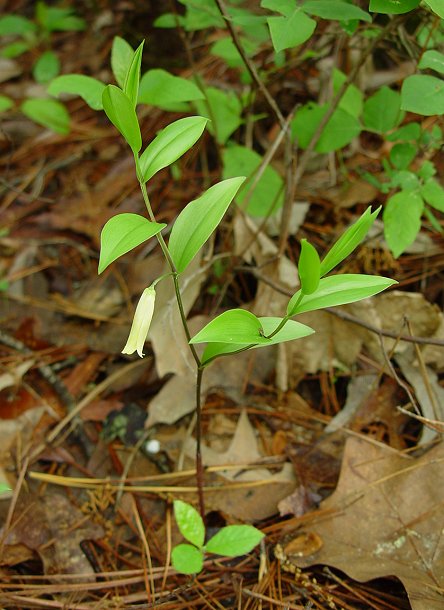Uvularia sessilifolia L.
Small Bellwort

Native
CC = 8
CW = 3
MOC = 16
© DETenaglia
Uvularia sessilifolia L.Small Bellwort | |
 |
Native CC = 8 CW = 3 MOC = 16 |
© DETenaglia |
|
Family - Liliaceae Habit - Perennial forb from long, slender rhizomes. Roots not thickened. Stems - Erect, flexuous, arched, or most commonly recurved near the tip, to 40 cm, usually forked into 2 branches above the middle, not hollow, glabrous. Leaves - Alternate, the basal few reduced to bladeless sheaths, the remainder sessile, 3.5-8.0 cm long, glaucous, glabrous on the undersurface, numbering 0-2 below the fork and several above the fork. Inflorescences - Solitary at the tips of short, axillary branches with 0 or 1 leaves, appearing axillary. Flowers - Perianth bell-shaped, 1.2-2.5 cm long, the sepals and petals free, linear to narrowly elliptic or narrowly oblanceolate, pale yellow. Stamens 6, free. Style 3-lobed, each narrow lobe with a linear stigmatic area on the inner surface near the tip. Ovary superior, sometimes short-stalked, with 3 locules, each with 2-6 ovules.
Fruits - Obovoid, 3-lobed capsules 8-15 mm long, the tip pointed, the angles winged. Flowering - April - May. Habitat - Mesic and bottomland forests, rich or alluvial soils, low woods along streams, north-facing bluffs. Origin - Native to the U.S. Lookalikes - U. grandiflora, which is much more common in Missouri. Other info. - This species is much less common in Missouri than the closely related U. grandiflora, with a strange distribution consisting mainly of a few scattered locations in both the northeastern quadrant and southeastern regions of the state. It has not been collected in the northeastern quadrant for over 50 years. The range within the continental U.S. is also eccentric, with lots of collections in Arkansas and states north of Iowa, but relatively little in Iowa or Missouri. It is more common in Atlantic Coast states, particularly in New England. The plant is easy to identify in flower because of its sessile but non-clasping leaves and pale yellow flowers, which are shorter than those of U. grandiflora. Vegetatively the plant can be confused with a few others but the branching stems are a good character to look for in the field. Photographs taken at the Weymouth Woods Sandhills Nature Preserve, NC., 4-26-03 (DETenaglia). |